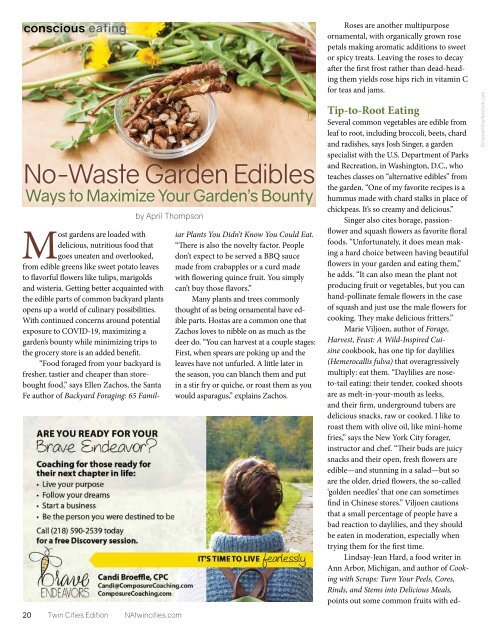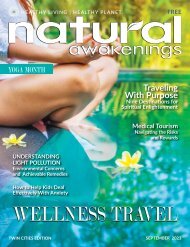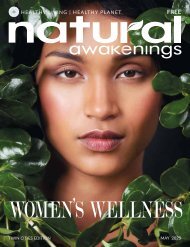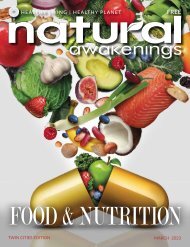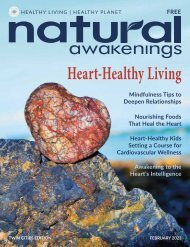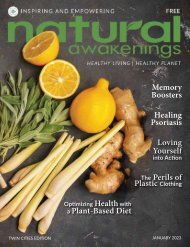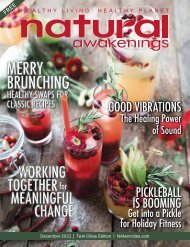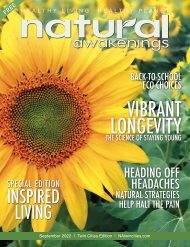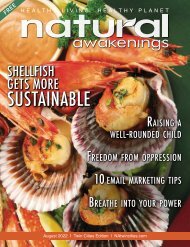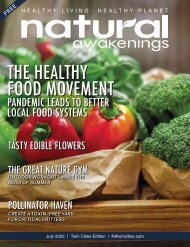Natural Awakenings Twin Cities August 2020
Read the August 2020 edition of Natural Awakenings Twin Cities. This month we focus on Biological Dentistry and Social Justice. Includes articles on no-waste garden edibles, environmental justice issues, interviews with local primary candidates, and more. Natural Awakenings Twin Cities magazine is your source for healthy living, healthy planet information. Have you visited our website lately? Sign up for our Newsletter and Digital Magazine, read archived articles from local experts, and keep up with local healthy living events. Visit NATwinCities.com today.
Read the August 2020 edition of Natural Awakenings Twin Cities. This month we focus on Biological Dentistry and Social Justice. Includes articles on no-waste garden edibles, environmental justice issues, interviews with local primary candidates, and more. Natural Awakenings Twin Cities magazine is your source for healthy living, healthy planet information. Have you visited our website lately? Sign up for our Newsletter and Digital Magazine, read archived articles from local experts, and keep up with local healthy living events. Visit NATwinCities.com today.
You also want an ePaper? Increase the reach of your titles
YUMPU automatically turns print PDFs into web optimized ePapers that Google loves.
conscious eating<br />
No-Waste Garden Edibles<br />
Ways to Maximize Your Garden’s Bounty<br />
by April Thompson<br />
20 <strong>Twin</strong> <strong>Cities</strong> Edition NAtwincities.com<br />
Most gardens are loaded with<br />
delicious, nutritious food that<br />
goes uneaten and overlooked,<br />
from edible greens like sweet potato leaves<br />
to flavorful flowers like tulips, marigolds<br />
and wisteria. Getting better acquainted with<br />
the edible parts of common backyard plants<br />
opens up a world of culinary possibilities.<br />
With continued concerns around potential<br />
exposure to COVID-19, maximizing a<br />
garden’s bounty while minimizing trips to<br />
the grocery store is an added benefit.<br />
“Food foraged from your backyard is<br />
fresher, tastier and cheaper than storebought<br />
food,” says Ellen Zachos, the Santa<br />
Fe author of Backyard Foraging: 65 Familiar<br />
Plants You Didn’t Know You Could Eat.<br />
“There is also the novelty factor. People<br />
don’t expect to be served a BBQ sauce<br />
made from crabapples or a curd made<br />
with flowering quince fruit. You simply<br />
can’t buy those flavors.”<br />
Many plants and trees commonly<br />
thought of as being ornamental have edible<br />
parts. Hostas are a common one that<br />
Zachos loves to nibble on as much as the<br />
deer do. “You can harvest at a couple stages:<br />
First, when spears are poking up and the<br />
leaves have not unfurled. A little later in<br />
the season, you can blanch them and put<br />
in a stir fry or quiche, or roast them as you<br />
would asparagus,” explains Zachos.<br />
Roses are another multipurpose<br />
ornamental, with organically grown rose<br />
petals making aromatic additions to sweet<br />
or spicy treats. Leaving the roses to decay<br />
after the first frost rather than dead-heading<br />
them yields rose hips rich in vitamin C<br />
for teas and jams.<br />
Tip-to-Root Eating<br />
Several common vegetables are edible from<br />
leaf to root, including broccoli, beets, chard<br />
and radishes, says Josh Singer, a garden<br />
specialist with the U.S. Department of Parks<br />
and Recreation, in Washington, D.C., who<br />
teaches classes on “alternative edibles” from<br />
the garden. “One of my favorite recipes is a<br />
hummus made with chard stalks in place of<br />
chickpeas. It’s so creamy and delicious.”<br />
Singer also cites borage, passionflower<br />
and squash flowers as favorite floral<br />
foods. “Unfortunately, it does mean making<br />
a hard choice between having beautiful<br />
flowers in your garden and eating them,”<br />
he adds. “It can also mean the plant not<br />
producing fruit or vegetables, but you can<br />
hand-pollinate female flowers in the case<br />
of squash and just use the male flowers for<br />
cooking. They make delicious fritters.”<br />
Marie Viljoen, author of Forage,<br />
Harvest, Feast: A Wild-Inspired Cuisine<br />
cookbook, has one tip for daylilies<br />
(Hemerocallis fulva) that overagressively<br />
multiply: eat them. “Daylilies are noseto-tail<br />
eating: their tender, cooked shoots<br />
are as melt-in-your-mouth as leeks,<br />
and their firm, underground tubers are<br />
delicious snacks, raw or cooked. I like to<br />
roast them with olive oil, like mini-home<br />
fries,” says the New York City forager,<br />
instructor and chef. “Their buds are juicy<br />
snacks and their open, fresh flowers are<br />
edible—and stunning in a salad—but so<br />
are the older, dried flowers, the so-called<br />
‘golden needles’ that one can sometimes<br />
find in Chinese stores.” Viljoen cautions<br />
that a small percentage of people have a<br />
bad reaction to daylilies, and they should<br />
be eaten in moderation, especially when<br />
trying them for the first time.<br />
Lindsay-Jean Hard, a food writer in<br />
Ann Arbor, Michigan, and author of Cooking<br />
with Scraps: Turn Your Peels, Cores,<br />
Rinds, and Stems into Delicious Meals,<br />
points out some common fruits with ed-<br />
EKramar/Shutterstock.com


